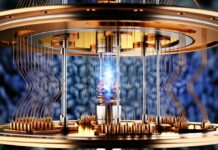The catch is that directly measuring the Hubble constant is very tricky. To do so, astronomers like Riess and Freedman must first find and calibrate “standard candles”: astronomical objects that have a well-known distance and intrinsic brightness. With these values in hand, they can infer the distances to standard candles that are fainter and farther away. They then compare these distances with how fast the objects are moving, revealing the Hubble constant.
Riess and his team use pulsating stars called cepheids as their standard candles. The stars’ distances can be measured with parallax and other methods, and they pulsate with a frequency that correlates with how intrinsically bright they are. This lets the astronomers gauge the relative distances to fainter cepheids in farther-away galaxies, which gives them the distances of “Type 1a supernovas” in those same galaxies — explosions that serve as brighter, though rarer, standard candles. These are used to measure the distances to hundreds of farther-away supernovas, whose recessional speed divided by their distance gives the Hubble constant.
Riess’s team’s Hubble value of 74 became more convincing last year when an independent measurement using quasars yielded the similar result of 73.3, a measurement based on objects called masers landed at 73.9, and an additional independent quasar measurement returned 74.2.
But Freedman, who helped pioneer the cepheid method now used by Riess, has long worried about possible sources of error. Cepheids change as they age, which is not ideal for standard candles. Cepheids also tend to exist in dense stellar regions, which has two nefarious effects: First, those regions are often filled with dust, which blocks starlight and makes objects look farther than they are. And second, crowding can make them look brighter and thus closer than they are, potentially leading to overestimation of the Hubble constant. That’s why Freedman set out to use tip of the red giant branch stars.
TRGBs are what stars like our sun briefly become before they die. As red giants, they gradually grow brighter until they reach a characteristic peak brightness caused by the sudden ignition of helium in their cores. These peaking red giants are always the same, which makes them good standard candles; moreover, as old stars, they inhabit the clean, sparse outskirts of galaxies, rather than dusty, crowded regions. “In terms of simplicity, tip of the red giant branch wins hands down,” said Barry Madore, Freedman’s husband and main collaborator, also of Chicago and Carnegie Observatories.
First, Freedman, Madore and their team had to calibrate the TRGB stars, figuring out how bright they are at some known distance. Only then could they compare the brightness (and thereby deduce the distance) of TRGBs and supernovas farther away.
For their standard candles, they chose the population of TRGB stars in the Large Magellanic Cloud, a nearby galaxy whose distance is extremely well known. The Large Magellanic Cloud is dusty, so the stars’ brightness can’t be directly observed. Instead, Freedman and her collaborators measured the intrinsic brightness of TRGBs in two other, essentially dust-free (but not as precisely located) places: a galaxy called IC 1613, and the Small Magellanic Cloud.
TRGBs in these pristine places are like the sun when it’s high in the sky, whereas TRGBs in the Large Magellanic Cloud are like the sun near the horizon — reddened and dimmed by the dust in the atmosphere. (Dust makes objects look redder because it preferentially scatters blue light.) By comparing the colors of stars in dusty and clean places, the researchers could infer how much dust there is in the dusty region. They found that there’s more dust in the Large Magellanic Cloud than previously thought. That revealed how much the dust dims the stars there, and thus how bright they truly are — allowing the stars to be used as standard candles.
The team independently checked the relative distances of the Large and Small Magellanic Clouds and galaxy IC 1613 using other methods, and they performed a number of other consistency checks on their result. Their TRGB distance ladder yields a Hubble value of 69.6, well below the measurements using cepheids, quasars and masers and within shouting distance of the prediction from the early-universe data.








